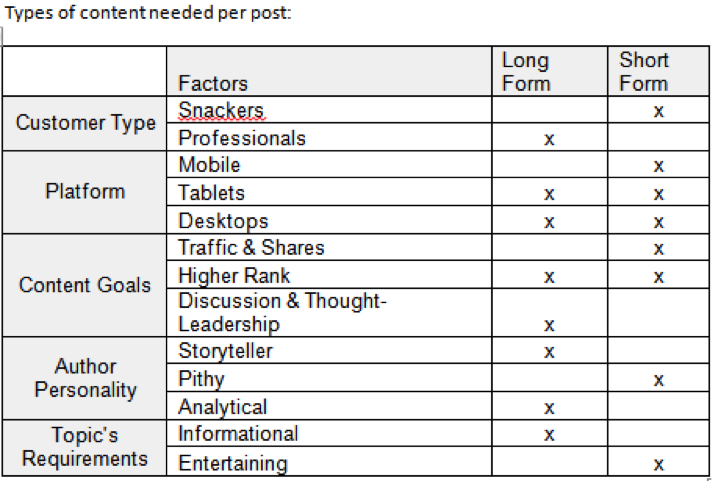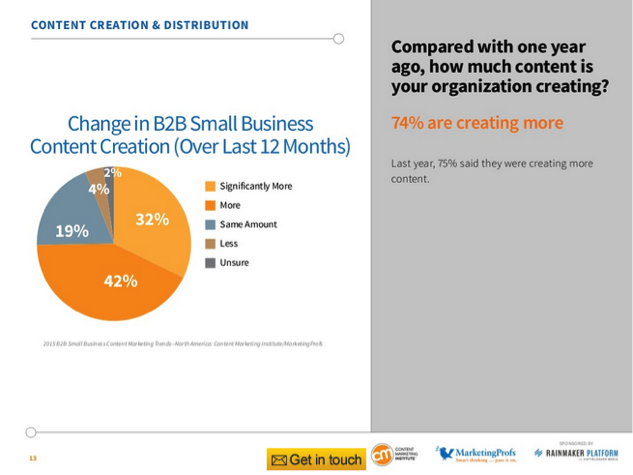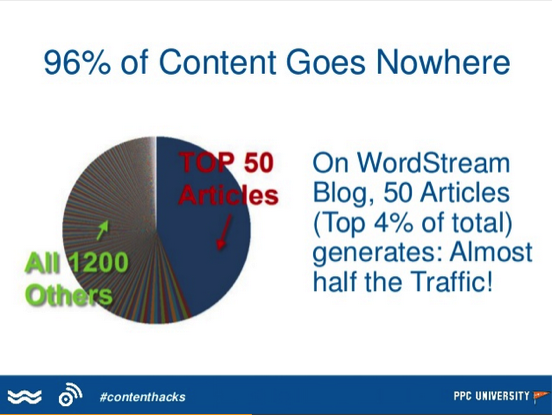As Google relies on a wider variety of link and social sources, content marketing has taken the cake. Yet another Google algorithm was released in early May that laser focuses on quality content. Everyone is in the content game, but few are effectively combining content and search strategy. We need to look into where content is heading and how we can best utilize strategic content creation to both increase awareness and build brand loyalty. 86% of B2B businesses are utilizing some form of content marketing, and 87% of organizations claim that lead generation is an important goal of a content strategy.
A key piece missing in many content marketing strategies is how to optimize an article for Google’s Panda algorithm. Search engines have been coy about what makes “great content.” Do social shares help improve content? What about length? Should my article use the target keyword at least 8.76 times? What about linking to other sites? Will I lose my Google Juice (Googijuice)? All of these questions and more will be answered below:
1. Do social shares help improve Google rankings for content?
Yes, in a way. Yelp, Better Business Bureau, and Amazon all have a direct effect on an organization’s overall reputation. Facebook, Google+, Twitter, LinkedIn, and Pinterest have an indirect effect on search by allowing more users to click to your site and potentially link to your article on their website. Social media has very strong trust between users, which usually results in users completing the desired action on a website (read an article, sign up for a newsletter, view multiple pages, etc.). Search engines vary by where ‘creators’ exist; finding the search engine where users are likely to link to your site is the key. Search engines attempt to gauge the expertise and trust of each page, and strong social signals have a direct correlation with these factors.
2. How long should my article(s) be?
Testing out various types of content should be a priority for any content marketing plan until it becomes evident which type of content best fits your market. Long form content has proven to have a higher chance for ranking, primarily because the expertise required to produce long form content earns more active readers than a short news bite. Although long form content ranks better, users on mobile devices prefer short, efficient content. For sharability, video and interactive content are best. A great content marketing plan utilizes a mixture of four types of content:
Thought Leadership: expertise directly from the organization with specialized knowledge
Long-Form Content: in-depth articles diving deep into a topic with actionable insight
Newsworthy/Trend Content: short-form content to help keep readers informed
Evergreen Content: content that is always useful
A great way to test content is to have your organization create thought leadership and newsworthy content while outsourcing long form and evergreen content. Test a variety of articles, then use Google Analytics data to determine what is performing best for your organization.

3. How many times should I include a keyword and how to optimize for this keyword?
The old rules of placing a keyword multiple times throughout your copy have lost much of their importance. In fact, keyword stuffing can actually be detrimental to your search strategy. Nowadays, it is more beneficial to utilize a wide variety of synonymous keywords throughout your copy, all while ensuring your tone is natural and balanced. Keyword stuffing is a thing of the past, but quite a few great strategies still exist to get the most out of keyword optimization.
If you are creating long-form content, consider utilizing the Skyscraper method to bulk up your content beyond competitors and pack in a huge variety of similar keywords. Creating more content in a natural way allows for search engines to easily define your ‘main content’ and intelligently piece together the primary purposes of the article (thus, creating multiple keywords for your article).
Keyword clumping is another great strategy to utilize without feeling spammy. Attempt to categorize each paragraph of your article into one specific subject. This paragraph is about keywords in content marketing articles. The next paragraph will be coordinated around another topic in this blog. All paragraphs will have a specific theme which feed into the overall whole of the article. The way machine learning works is to quickly crawl content and determine what is the true nature of the article, not just what you deem appropriate from your meta data.
4. Should I include links to other sites in my article?
The original Google algorithm utilized links as the primary ranking signal for a page. If page A received 100 backlinks and linked out with 3 backlinks, then it would be considered 97 links strong. The algorithm has evolved to weigh each link on the Internet by the power behind the domain, taking into account each individual website’s trust authority, as well as removing the loss of power from linking others from your site. The concept of “inbound:outbound” links no longer applies. Today, search engines consider outbound links to reputable sources as a positive trust signal, which helps a page’s overall ranking.
Search engines want sites to cite their sources. It does you no good to ‘borrow’ content or nofollow all links on your page unless you are following Google’s quality guidelines. The web has evolved to reward content in the same way academia treats publishers: well-known influencers are more likely to publish well-regarded content because they have a history of creating original, intuitive content.
5. Why does no one click on other pages of my website?
With a content marketing strategy, our primary goal is to get users to consume your content. Once they have enjoyed your content, they are likely to leave your website unless you provide a VERY good reason to stay. A strong side bar, like the Roasterie, or inline text, is a great way to draw users further into your website toward your ecommerce products. If you are not selling a product, make sure to have robust call-to-action above and below the article to grab the user’s attention without detracting from the article. Each viewed page is a new opportunity for a user to further connect with your organization.
6. How do I get to the top of Google search with ALL of my content?
You won’t. For every great article, there are 20 good articles and 100 average ideas. As Larry Kim from WordStream found, 96% of content goes nowhere. This shouldn’t get you discouraged, though. The key to a great content strategy is listening to the market and determining what your user needs. Spend more time utilizing tools, such as BuzzSumo, to research your audience before you begin writing your article. This helps to improve your chances of success as well as provide additional insight into your customer’s online persona. Don’t create low-quality content, but do keep a regular schedule of content that is well researched and relevant for your audience. When you do have a truly awesome article, make sure to promote your post on Facebook, Twitter, and LinkedIn to ensure it gets in front of influencers. An additional strategy for this is to utilize your brand advocates by creating a custom audience in Facebook that ensures impressions from your advocates (and influencers).
Many sites also lack original photography. Grabbing random stock photography is quick and easy; however, non-original content generally does not rank in Google image search. I can place some awesome stock photography here, but dozens of other sites can place the same photo as well. Taking the time to create some original images will improve the likelihood of your content, ranking in both search and universal image search, which is a double whammy for your site. Don’t forget to add some img alt text to your photo to ensure search engines understand the photo content (and comply with ADA).

7. Should I have comments on my content? How do they affect ranking?
Yes, comments do assist in ranking. A post with an actively engaged comments section is a clear signal that the page has value, even if some of those comments are negative. Inviting your users to comment on a blog post with their opinion can often lead to active discussions around your blog topic. By inviting your users to share their stories, you are establishing a relationship that can grow into a sale. After users comment, engaging with the comments section is the perfect way to show that you care about your visitors and that their voices are heard. People love to hear from the author, it shows validation that their opinion is important. Visitors are more likely to become engaged if they feel their voices are heard.
When using WordPress or Drupal, only enable comments on pages you seek to engage user comments. Avoid leaving the comments section on static pages. If your site is not fostering an active comments section, here are some tips to improve comments on your posts:
-
Take a stand on your topic.
-
Ask for help.
-
Comment on other blogs in your industry.
-
Accept guest posts on your blog.
-
Extend the conversation by posting additional information on your post in the comments section.
8. Can I make mad money by placing ads on my page?
Maybe, but this strategy has faded. In fact, Google expects the most important page elements (header and copy) should be exactly where the user expects and not obscured by huge pictures or lots of ads. Placing banner ads above your content is a negative signal and can hurt your chances of ranking for quality content. It is great to connect your site to the AdSense network, but only the highest traffic blogs earn substantial income through page ads. If your site traffic is less than 100k users per month, placing display ads on your site is not going to generate enough revenue to be worth the space allocation. Building better internal links and call-to-actions are a better investment of your time.
9. Should I have Google crawl my Tags and Categories?
No, Google has clarified that these pages are thin content and should be noindexed, nofollowed. Smaller blogs can work around this rule for a short  time, but it will eventually be banished to supplementary content hell and deindexed. Search engines seek to index the most relevant content for a specific search query. Tags and Categories organize your content for user experience, but do not assist a searcher in answering a specific query.
time, but it will eventually be banished to supplementary content hell and deindexed. Search engines seek to index the most relevant content for a specific search query. Tags and Categories organize your content for user experience, but do not assist a searcher in answering a specific query.
As your site grows, Tags and Categories contribute to your overall crawl budget. Owners of large sites often catch a disparity between indexed pages and total pages within a website. The Google algorithm update Caffeine ensures that the freshest (newest) content is more actively crawled and indexed. This can be seen very directly with Tags and Categories. Specifically, the 1st categories page can be indexed, but subsequent pages are not (even page 2). Since most sites paginate Categories and Tags, the subsequent pages are NOT indexed. What does this mean? If your site shows the five most recent blog pages on the first page, the second page is going to rank lower, and the third page may not rank at all.
If you have a WordPress site, make sure to noindex tags, categories, and other taxonomies. Also, make sure to noindex the subpages of archives. This will give your fresh content the most bang for its buck! Need help with creating a robots.txt file? Consider asking a search professional for assistance.
10. Does tone effect search rankings?
Tone should ALWAYS be natural to your industry. It is okay to have a professional tone if you are a B2B industry, but a fun organization should be fun. The caveat here is that your site should have no spelling errors, and grammar should appear to come from the location you live. Thus, if you reside in the US, it is not good to have simplistic sentences that would normally be written by outsourced writers (or a 5-year-old). Always aim to have content that resonates with your user, and that content will resonate with search engines.
[more]
BONUS ROUND….
Any other awesome factors to consider?
Yes. Did you know showing your company address throughout your site (with schema.org markup) will improve rankings? Schema.org is a bit technical, but the basis is simple: add some extra HTML to site content to specifically tell search engines what type of content you are showcasing. Schema.org information is also known as Rich Snippets, so don’t get confused if you see this term floating around on the Internet.
You can use schema.org tags for addresses, recipes, user reviews, price, and many other areas. Adding this data to your company will assist search by verifying that your business is REAL. Search engines are in the business of trust; they seek to be the ultimate source of information for all users. It’s easy to game the system on the Internet … just think about the many fake profiles that exist in social media. To combat fake business, schema.org allows search engines to connect your online presence with your brick-and-mortar address. As long as you have a local search presence, adding your company address to your site footer will give you a boost in Trust. Improving trust will improve search rankings.





